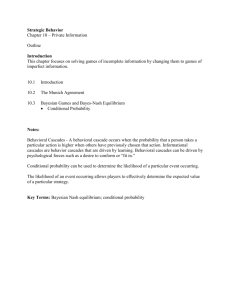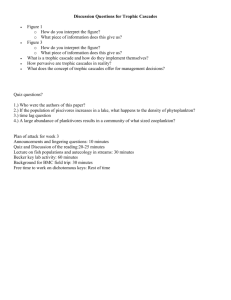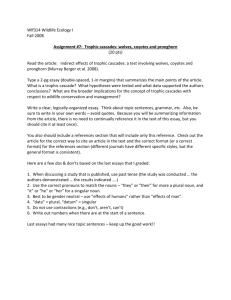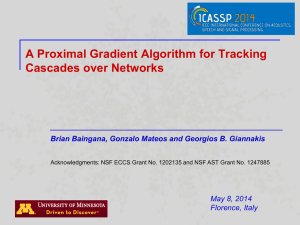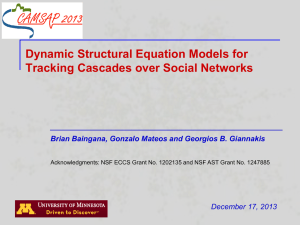Analyzing Politics without Equilibrium Assumptions
advertisement
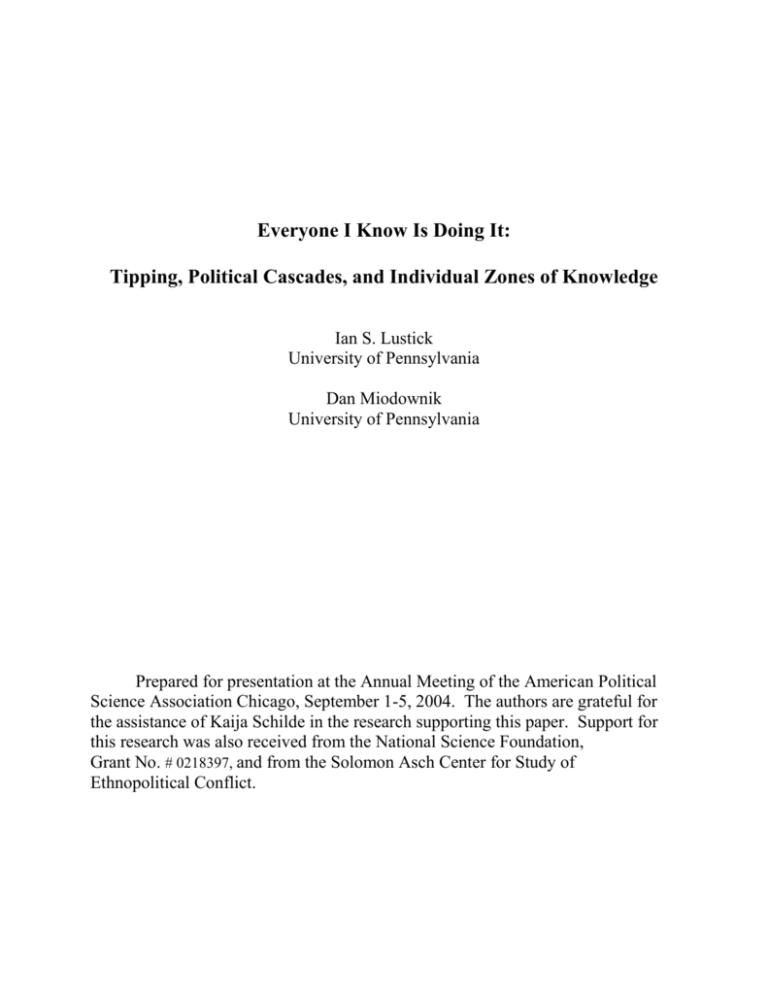
Everyone I Know Is Doing It: Tipping, Political Cascades, and Individual Zones of Knowledge Ian S. Lustick University of Pennsylvania Dan Miodownik University of Pennsylvania Prepared for presentation at the Annual Meeting of the American Political Science Association Chicago, September 1-5, 2004. The authors are grateful for the assistance of Kaija Schilde in the research supporting this paper. Support for this research was also received from the National Science Foundation, Grant No. # 0218397, and from the Solomon Asch Center for Study of Ethnopolitical Conflict. Tipping, Political Cascades, and Individual Zones of Knowledge Lustick and Miodownik 2 Analyzing Politics without Equilibrium Assumptions The principle of equilibrium, or at least the assumption of equilibrium, is a powerfully attractive force in the social sciences. It promises that at some strategic level of analysis soluble equations can capture steady realities.1 For systems dominated by non-conscious or non-rational elements equilibrium is achieved by homeostatic processes. A thermostat registers an increase in heat and at a certain threshold shuts down the furnace. The falling temperature, meeting a lower threshold, triggers the thermostat to fire the furnace, and the temperature achieves an over-time equilibrium or “ultrastability.” When conscious beings are imagined as the key elements in a system, “negative feedback” is called upon as the mechanism which keeps the system in equilibrium, or almost always moving toward it. The contemporary discipline of economics has been thoroughly dominated by equilibrium based approaches. The tropes associated with equilibrium analysis have also been the basis for structural-functional analysis in sociology and anthropology and have powerfully shaped the disciplines of psychology and political science. Of course in political science the entire school of rational choice is based on equilibrium models as they emerged via social choice and game theory from neoclassical economics. In these various domains of scientific work scholars employing the metaphor, principle, or mathematical requirement of equilibrium, use laws of supply and demand, reinforcement, and marginal return thinking at the individual level to produce stable prices, norms of Pareto optimality, social systems, learning, and stable polities. Driven by the law of diminishing returns, neither any one value in the system, nor the system as a whole, can go rapidly into an extreme range and stay there, dragging the system away from the “equilibrium path.” In such a Tipping, Political Cascades, and Individual Zones of Knowledge Lustick and Miodownik 3 system the particular point of equilibrium is determined by exogenous distributions of capabilities, resources, scarcities, and preferences. In the natural sciences, phenomena such as cyclones, avalanches, nuclear reactions, and firestorms, have long made it obvious that an expectation of equilibrium might better be considered only one, and perhaps, a very particular outcome or useful assumption about a system. Until the 1980s the social sciences, and in particular economics and political science, strongly resisted the abandonment of equilibrium as a master assumption. However, beginning in the 1980s and gathering strength within the last decade and a half, has been a movement, or several movements in different disciplines, to shift assumptions and expectations. Among the intellectual commitments of these related movements are replacement of expectations of a single equilibrium point with expectations of multiple equilibria; consideration of positive feedback loops and dynamic processes and patterns as normal rather than exotic; focus on the role of chance or history or path dependence in the determination of outcomes rather than system wide efficiency criteria, and concern with positive rather than negative feedback loops—vicious or virtuous circles, rather than countervailing forces.2 One particular kind of phenomenon with features difficult to study using traditional equilibrium oriented techniques is “tipping” or the appearance and operation of cascades. Long a crucial element in studies of epidemics, cascades or tips have been the analytic focus of sophisticated work in political science, psychology, and economics.3 In work by Timur Kuran, Kuran and Cass Sunstein, Susanne Lohmann, Murat Somer, and David Laitin, on anti-regime mobilization, protest behavior, ethnic polarization, or language adoption, equilibrium driven models are replaced by mechanisms of cascades of change or "tipping points," to explain sudden Tipping, Political Cascades, and Individual Zones of Knowledge Lustick and Miodownik 4 and large scale transformations of politically relevant behavior in populations of boundedly rational actors.4 In this paper we use agent-based modeling techniques of experimentation in carefully constructed virtual worlds to formalize, clarify, and test claims (or implicit beliefs) about the determinants of cascading patterns of political change. One objective of ours is to increase the precision and scope of thinking about cascades and to advance discussions of political tipping points beyond what the field presently offer—arguments that are often intriguing, plausible, and suggestive, but also too impressionistic or too reliant on radical and unstated ceteris paribus assumptions to produce strong theories of the factors that produce cascades or inhibit them. Our larger purpose, however, is to demonstrate the crucial and perhaps indispensable role that agent-based modeling can play in the exploration and evaluation of implicit assumptions concerning the populations within which these theories imagine equilibrium as an outcome or an explanation. Among these assumptions are those pertaining to spatiality and local knowledge, general cognitive limits, variability and etiology of preferences across time, and degrees and distributions of heterogeneity. In this paper we will raise and address just one issue: the role of “spatiality.” By spatiality we mean variation in the size of the zone of knowledge available to individuals, i.e. in the amount of access that individuals in a population have to information about a specific subset of that population rather than to parametric information about the population as a whole. The specification of the subset of the population with which an individual has more contact than with others can be a function of geography, that is, strictly speaking, spatial relations, but it can also be social. Thus someone's zone of knowledge, or social "neighborhood," reflects the subset of the population with which he or she has more Tipping, Political Cascades, and Individual Zones of Knowledge Lustick and Miodownik 5 regular and intense conflict, regardless of whether that regular and intense conflict is a function of physical proximity. For example, many suburbanites can have regular contacts with their workmates in the city, and barely every meet the people who live across the street from them. Cascades, Tipping Points, and Patterns of Political Mobilization Consider that virtually all of this kind of work invokes the seminal contribution of Thomas C. Schelling’s classic analysis of cascades toward segregation arising from relatively small amounts of prejudice in a mixed black, white population. Schelling used a checkerboard as a simulation tool to explain segregation among the races arising from relatively small amounts of preference for same race neighborhoods.5 We use computers; Schelling did not. But the principle of investigating the production of non-linear transformations in behavior from simple incremental decisions by discrete, locally interacting agents is identical. It is just that we use computer simulation to overcome limits on the intricacy and discipline of the kind of thought experiment Schelling invented. What is of particular interest to us is that the vast majority of this work abandons the spatial, or local, aspect of Schelling's analysis One key simplification they introduce into their models is that individual agents receive information about their world via a sample of the entire population, or through signals of variable reliability about the behavior of the population as a whole, rather than by monitoring and being influenced by a particular (and not necessarily representative) subset of the population with which they happen to have contact. Indeed the overwhelming majority of studies of cascades, especially "information cascades" (when the behavior of members of a population converge rapidly and in an accelerating pattern due to a changes in signals each receives about the behavior of others), treat individuals as locally blind. In these models this radical stipulation, that no one individual can distinguish other individuals from one another or even observe the Tipping, Political Cascades, and Individual Zones of Knowledge Lustick and Miodownik 6 behavior of other individuals, is usually justified by the need for analytic tractability. Instead individuals are allowed only reports about the prevalence of a kind of behavior in the entire population at a particular point in time. Thus speakers of a minority language can know roughly how many other members of the population are speaking the majority language, but not which ones are doing so. Children can know that 10% of children in their world are using hula-hoops, but cannot know whether children with whom they have immediate contact are using them, or if so, which they are. Unhappy citizens in a dictatorial regime can only know changing estimates of the number of participants in anti-government demonstrations. They do not know which of their neighbors and acquaintances, or how many of them, are demonstrating. Kuran's work is the most thorough and transparent attempt to model cascades of political mobilization. He has tried admirably to formalize his argument. In its precisely rendered, albeit minimalist, form, it claims that cascades can (not that they necessarily will) arise when there are differences across individual with respect to their willingness to suppress or express true feelings in light of costly consequences. In these formulations there is no reference to interaction spaces within which individuals monitor the behavior of particular others, or some specific subset, of the whole population.6 Interestingly, in the discursive descriptions of tipping phenomena Kuran sometimes provides to support this analysis the proximity of individuals to one another in densely interacting clusters can play a key role. For instance, Kuran describes the outbreak of the 1917 Bolshevik revolution as follows: On February 23, the day the uprising began, many residents of St. Petersburg were standing in food queues, because of rumored shortages. Some twenty thousand workers were in the streets after being locked out of a large industrial complex over a wage dispute. Hundreds of off-duty soldiers were Tipping, Political Cascades, and Individual Zones of Knowledge Lustick and Miodownik 7 outdoors, looking for distraction. And as the day went on, multitudes of workers left their factories early to march in celebration of Women’s Day. The combined crowd quickly turned into a self-reinforcing mob. It toppled the Romanov dynasty in four days…7 In David Laitin’s studies of changing patterns of language use the concepts of tipping and "tipping point" are deployed to “specify the point in the national project when leaders would have an incentive to use violent tactics.” 8 A “tipping game” is also developed to explain intergenerational language change, and the role that violence and the threat of violence might play in such transformations. The narratives Laitin presents to illustrate and support his analyses include clustered networks of speakers of distinct languages and direct access to early language adapters by titular language enforcers.9 However the tipping model itself does not include these (perhaps crucial) spatial or network features. As in Kuran's model, as well as for Somer and Lohmann in their treatments of cascades, individuals in Laitin’s model do not base their choices on information about subsets of the population with which they have more interaction or more intense interactions than they do with others. Instead they sample the entire population for the proportion of it that is in a particular category (minority language speaker, bi-lingual, majority language speaker, etc.). Cascades and Agent-Based Modeling: Rendering Spatiality Tractable Agent-based modeling approaches problems from the bottom up. Agents with diverse but controllable attributes interact locally according to stipulated algorithms that can be designed to mimic interesting mechanisms. Large batches of virtual histories (or futures) can then be produced using random seeds to engineer carefully controlled experiments focusing on the Tipping, Political Cascades, and Individual Zones of Knowledge Lustick and Miodownik 8 effects of mechanisms or attributes of theoretical interest. In the experiments reported here we use computer assisted agent-based modeling simulations to overcome the analytic tractability problem, thereby permitting the reintroduction of the spatial aspects of information availability (often referred to, in n dimensions, as small worlds effects). We can then ask about the implications of variation in the amount of “local knowledge” available to individuals for some of claims that have arisen in this literature on political cascades. Agent-based modeling is also attractive as an approach to the study of cascades because, while not forbidding stable equilibria, it does not assume or require them. Indeed, rooted in theories of complexity and evolution, it directs attention to the relatively sudden emergence of order of magnitude transformations—non-linear shifts from multitudinous micro-processes into macro-patterns. Rooted in the cumulative result of the continuous operation of simple but widely distributed mechanisms, it also naturally encourages a focus on dynamic, historically embedded processes of change. Each of these considerations—spatiality, non-linearity, the absence of stable equilibria, the operation of widely dispersed mechanisms, and strong pathdependence--is an obstacle to studying cascading phenomena with approaches anchored in or aspiring to closed form solutions.10 In an agent-based modeling context, the "Moore neighborhood" is the subset of the population of agents in the geographical proximity of one agent whose behavior it monitors. If agents are square shaped, as is the standard, and if each position in the grid is filled (inhabited), then each agent with a small Moore neighborhood can see eight others, in addition to itself (those adjacent to its four sides and those touching its corners). We refer to such an agent as having a "sight radius" of one. An agent with a sight radius of two would see, in addition to itself and its eight immediate contacts, a concentric "ring" of sixteen additional agents for a total of 25 within Tipping, Political Cascades, and Individual Zones of Knowledge Lustick and Miodownik 9 its sight radius. The smaller the sight radius of agents in a landscape, the more "local" are the interactions driving the behavior of individual agents and therefore driving the behavior of the array as a whole.11 The variable of "spatiality" can be conceived as the degree to which a larger or smaller proportion of the space of the total population of possible participants in a cascade are directly considered by individuals as they make their decisions about how to behave. Spatiality can be removed from the analysis by imagining that agents are wholly solipsistic, and observe nothing about their neighbors or any other agents in the population or by assuming that all agents observe all other agents all the time. It is this second assumption, involving the complete removal of spatiality, which is, as we have emphasized, a principal assumption of most of the literature on cascades. The operational meaning of this (usually unstated) assumption is that the sight radius of all individuals (agents) in a population must be big enough to include all others in that population. Standardly, each individual is treated as viewing either the entire population, some proxy signal (noisy or accurate) for the state of the entire population, or a random subset of the population sampled from it with no restrictions based on absolute or relative location to the observing agent. This practice is necessary to make models of cascades tractable algebraically. The analytic sacrifices arising out of this necessity, however, are seldom identified or addressed. An agent-based modeling perspective makes the nature of the analytic sacrifice clear. We can immediately see how special and extreme is the world to which analysts of cascades have been forced to confine their attention in order to achieve algebraic "tractability." Agent-based modeling can not only help see the problem, but solve it as well, by including variation in spatiality within a systematic, fully transparent, albeit non-algebraic analysis. Tipping, Political Cascades, and Individual Zones of Knowledge Lustick and Miodownik 10 Experimental Design Systematic experimentation requires titrating the amount of spatiality present in populations under study. This is accomplished by varying the sight radius of agents. We can then observe the effect of change of this attribute of individual agents on patterns of cascading outcomes as an attribute or behavioral characteristic of the population as a whole. Toward this objective we used the PS-I agent-based modeling computer simulation platform to develop a tippy model comprised of 2500 agents in square shaped toroidal grid.12 Each agent has two affiliations—red [0] and green [1]. For each agent at any point in time (time-step) one of these two "identities" or "ways of being" is displayed, or "activated" and the other is latent. By randomizing the initial distribution of activated identities among agents we produced one hundred arrays, or "landscapes." In each of these initializations of tippy, there are exactly 1250 agents activated on red and 1250 activated on green, but their spatial distribution is uniquely determined by a random number generator. By running these 100 snapshots forward in time under variable conditions we can achieve a carefully controlled experiment focusing on the contribution which the treatment condition makes to individual outcomes for each of the particular geographies that each snapshot represents and for the pattern of outcomes across all 100 geographies within each treatment condition. In this way we can control for the particular ways a specific amount of spatiality at the agent level might manifest itself in a population of such agents. In order to study the impact of variation in spatiality we incrementally increased each agent’s sight radius (SR) from 1 to 4. In this model each agent’s decision to adopt a new behavior or maintain current behavior is wholly the product of an interaction between the information acquired by examining agents within the agent’s sight radius and the decision rules Tipping, Political Cascades, and Individual Zones of Knowledge Lustick and Miodownik 11 for when to “rotate” a new behavior or identity into activation. Since each agent sees itself within its sight radius there are 9 agents (including self) surveyed by each agent when agent sight radius is set at 1; 25 agents surveyed when sight radius is set at 2; 49 when sight radius is 3; and 81 when sight radius is set at 4. Figure 1 depicts the implications of the four different site radii that we used in our experiments. The light gray cells along the outer rim of the display would be included if the sight radius of Agent A were extended to 5. Each run, or tippy history, was put in motion for 200 time steps, with agents synchronously updating on each even time step. We produced 100 of these histories for each SR setting of 1, 2, 3, and 4. Figure 1: Sight radius 4 4 3 3 2 2 1 1 A 1 2 3 4 1 2 3 4 Beginning with landscapes evenly divided between 1250 agents activated on red and 1250 agents activated on green, we define a tip as a transformation of the landscape, over a 200 time step period, to a landscape that 100% distribution of one activated identity, either red or green.13 Tipping, Political Cascades, and Individual Zones of Knowledge Lustick and Miodownik 12 Results Figure 2 displays data from four hundred runs. We display in this figure not only the number of tips, but the average amount of change toward a tip in the 100 tippy histories generated within each condition. Figure 2: Spatiality and cascades of Identity Change Number of tips Percent of agents that changed identity 49 41 27.6 (sd 22.5) 24.1 (sd 22.2) tippy.mdl 2500 agents. At t=0 50% reds 50% greens. For all agents: RT=2, Influence=1. No bias 100 iterations, 200 time steps. Datafile: tippy5050.xls 9.3 (sd 6.9) 2.3 (sd 1.7) SR=1, 9 agents surveyed SR=2, 25 agents surveyed SR=3, 49 agents surveyed SR=4, 81 agents surveyed It is clear that with increasing “local knowledge,” that is with an increasing sight radius of agents and an increase in the number of agents surveyed by individual agents before they update their behavior, our two indices of cascading patterns of change also increase. We see both the average amount of identity change per history increase as the sight radius increases and we see that the number of full-blown “tips” increases from zero in the sight radius 1 and 2 conditions to 41 and then 49 out of 100 in the sight radius 3 and 4 conditions. Variation in the Tipping, Political Cascades, and Individual Zones of Knowledge Lustick and Miodownik 13 amount of knowledge available to individual agents about the general population thus seems to have a strong impact on the appearance of cascading patterns of change. Before interpreting these results for their theoretical significance we report two sensitivity studies we conducted in regard to our spatiality results. We wanted to see whether the pattern observed would be robust even if we employed a schedule for agent updating other than the strictly synchronous schedule we employed in the experiments reported and even if we reduced the density of agents interacting with one another. An ongoing debate among agent-based modelers pertains to the implementation of synchronous updating (all agents simultaneously perform a scan of their neighborhoods and update their behavior before the next updating occurs) and asynchronous updating (updating does not occur simultaneously and universally). On the one hand it is argued that synchronous updating is an arbitrary special case of the sequence in which such updating might be seen to occur. On the other hand, any updating schedule, including one that is randomized, is itself an arbitrary special case.14 Absent any theory to guide design of updating schedules, and considering that the time scale in this study is purely abstract (we are not thinking of updating intervals in terms of minutes, weeks, years, or centuries), it seems wisest, and easiest, to use synchronous updating. However, we did conduct a series of experiments in which asyncronicity of updating was introduced by setting half of all agents to update on the even time step and half on the odd time step, with these agents evenly divided among those activated on either Green or Red at t=0. Tipping, Political Cascades, and Individual Zones of Knowledge Lustick and Miodownik 14 Figure 3: Spatiality and cascades of Identity Change - Asynchronous update Number of tips Percent of agents that changed identity 70 68 34.5 (sd 18.8) 34.5 (sd 19.0) 15.8 (sd 11.7) 3.3 (sd 2.4) SR=1, 9 agents surveyed tippyOddEven.mdl 2500 agents. At t=0 50% reds 50% greens. Asynchronous update For all agents: RT=2, Influence=1. No bias 100 iterations, 200 time steps. Datafile: Tippyasync.xls 4 SR=2, 25 agents surveyed SR=3, 49 agents surveyed SR=4, 81 agents surveyed The pattern of increasing amounts of identity change and numbers of tips we found with synchronous settings was robust across this adjustment, though the rates of increase for both were more rapid. As displayed in Figure 3, the number of tips increased in three of the four conditions as follows: SR 1: 0 tips, 0 tips; SR2: 0 tips, 4 tips; SR3: 41 tips, 68 tips; SR4: 49 tips, 70 tips. In parallel fashion, and again corresponding to the pattern present with synchronous updating, the percentages of agents registering a change of identity at t=200 rose with each increase in the site radius. Although the averages are slightly higher across this condition, the pattern is the same. We thus find that our main results are not only robust across a toggle to asynchronous updating, but that the introduction of asynchronicity actually increases the sensitivity of cascading patterns of change to increases in the local knowledge of individual agents. Tipping, Political Cascades, and Individual Zones of Knowledge Lustick and Miodownik 15 We turn now to consideration of the effect of reducing by 50% the density of the population of agents interacting with one another. It has been shown that the density of populations also affects outcomes in the operation of cellular automata and intuitively it is fairly obvious that density of population would also affect outcomes with respect to cascades of change in real populations. The density of our grid in the tippy experiments reported here is 100%, in that each agent is bordered by a continuous, uninterrupted array of agents with no uninhabited cells. This permits us to specify exactly how many agents are in the sight-radius of each agent as that radius is increased. Figure 4 reports findings in a sensitivity study run by reducing the density by 50%. This was achieved by eliminating 50% (about 1250) agents from our 50X50 grid, substituting uninhabited spaces for a randomly selected set of 25%(about 625) initially green agents, and also for a randomly selected set of 25% initially red agents.15 Figure 4: Spatiality and Cascades of Identity Change – 50% reduction in density 25.9 (sd 18.5) Number of identity tips 22 19.2 (sd 13.7) 11.4 (sd 8.2) 5.2 (sd 3.6) 3 1.9 (sd 1.6) SR=1, 9 agents surveyed SR=2, 25 agents surveyed SR=3, 49 agents surveyed SR=4, 81 agents surveyed SR=5, 121 agents surveyed Percent of agents that changed identity: 50% grid Tippy50%.mdl 1250 agents in a 50*50 grid. At t=0 50% reds 50% greens. For all agents: RT=2, Influence=1. No bias 100 iterations, 200 time steps. Datefile: tippy50%grid.xls Tipping, Political Cascades, and Individual Zones of Knowledge Lustick and Miodownik 16 At first glance it may appear that a threshold of sorts is crossed between the SR 2 and SR 3 settings, marking a significant increase in identity change per history and the first (and very substantial) appearance of tipping. But it is important to note that the sight radius makes its contribution in terms of spatiality by increasing the number of agents seen by any one agent, and the rate of that increase is much steeper than the increase of one integer at a time in the sight radius itself. Still, although we will not pursue this question here, there are reasons to think there may in fact be such a threshold. It is noteworthy that whether each agent sees 9 (SR 1) or 25 (SR 2) agents, no tips occur. We first observe tips when agents see 49 agents (SR3). So there is a large increase in the rate of tips as the amount of local knowledge per agent increases by 24 agents. However, the increase in the rate of tips in the next condition, SR4, which entails an increase in the amount of local knowledge per agent of 32 agents, is quite small, rising from 41 in the SR3 condition to 49 in the SR4 condition. Discussion We draw three specific conclusions from these experiments. These conclusions, in the first instance, pertain to the virtual worlds we have created. However, insofar as the mechanisms and assumptions in those worlds are the mechanisms and assumptions contained in the models others use to think about the "real world," then these conclusions apply as well to those worlds. First, spatiality matters. Varying the amount of local knowledge available to agents in a population has a strong determining influence on the likelihood of rapid and comprehensive transformations of that population. Robustness studies suggest that the shape and power of this effect will itself vary in interaction with other features, including the density of the population and the sequences of decision-making prevailing within it. More specifically it appears that Tipping, Political Cascades, and Individual Zones of Knowledge Lustick and Miodownik 17 increasing local knowledge available to agents encourages cascades of change. Finally, the discontinuities suggested (though not proven) in our data indicate the likelihood of a “metatipping point,” a point, with respect to the amount of distributed local knowledge in a population, that when passed makes the production of tipping points very much more likely. In addition to these considerations we can also try to understand the mechanisms that are at work in the tippy world and wonder if those mechanisms could yield similar patterns in the real world. Close consideration of the dynamic patterns arising in our simulations as supported ideas developed elsewhere that cascades of change at one level of analysis must ultimately be traceable to tipping points toward cascades of change operating at lower levels of analysis. In our model we can understand the switch of an agent from activated on green to activated on red as a “tip” toward a new behavior arising out of the passing of a threshold, or trigger point, with respect to the balance of prevalence in the agent’s environment between each of the two competing identities. If a green agent encounters more red agents than green in its neighborhood, that will not prompt a switch to red unless the margin of superiority of red to green passes whatever pre-set “rotation trigger” exists within the green agent.16 This analysis implies that as the sight radius of agents in a population increases, while the internal trigger for activation of a different identity remains stable, a smaller percentage of the set of agents surveyed by each updating agent will be decisive in determining outcomes. As long as the distribution of different color identities is even, this should not change the likelihood of a switch in activation. However, it implies that agents with larger sight radii will be more sensitive, to slight imbalances in the distribution of different identity colors in their neighborhood. For this reason, what we may call “micro tips” (within each agent toward a new identity), will be more likely with a higher sight radius, assuming any unevenness at all in the Tipping, Political Cascades, and Individual Zones of Knowledge Lustick and Miodownik 18 spatial distribution of activated identities across the population. With an increase in the likelihood of micro-tips we almost automatically have an increase in the likelihood of “mesotips,” meaning the appearance, in specific regions of the population of clusters of agents activated on either red, or green. The question of whether this increase in meso-tips leads to a comparable increase in “macro-tips,” meaning that the entire population converges onto one of the two identity colors, is a slightly more complex question. For once substantial clusters of agents activated on a particular identity exist, the agents located within those clusters will be relatively strongly anchored in their current activation and require, if they are to change, that their sight radius be large enough to extend beyond their cluster and that the larger part of the population thereby accessed be disproportionately inhabited by agents activated on the alternate identity. Only, then, in a subset of populations characterized by meso-tips, will macro-tips be produced. It is in accordance with this analysis that we can explain otherwise puzzling findings, viz. the absence of macro tips at low sight radii settings, even if identity change at a low level does take place; a relatively sudden increase in the rate of macro-tipping associated with an increase in the sight radius; and a marked decline in the rate of increase in macro-tipping associated with increasing the sight radius once that sight radius itself has passed a certain (not precisely identified) point. Since the amount of cascading change that occurs is strongly linked to spatiality, with a direct if not completely linear relationship between local knowledge by agents and patterns of cascading, our results also imply a relatively strong critique of most of the existing literature. To the extent that models operate on the assumption that agents that are the decision units in cascades of behavior change act on information that is complete, or at least non-local, and if the Tipping, Political Cascades, and Individual Zones of Knowledge Lustick and Miodownik 19 real world to which those models are supposed to apply contains substantial amounts of spatiality (limited local knowledge of agents) then those models will very substantially over-predict the likelihood and robustness of cascades. Tipping, Political Cascades, and Individual Zones of Knowledge Lustick and Miodownik 20 1 Concerning the peculiar cross-disciplinary force of the equilibrium idea in Western natural science and science see Murphy, J.B. (1996). Rational Choice Theory as Social Physics. J. Friedman (eds.). The Rational Choice Controversy. New Haven, Connecticut: Yale University Press. 155-174 2 Arthur, Brian W. Increasing Returns and Path Dependence in the Economy. Ann Arbor: University of Michigan Press, 1994; Paul A. David, “Clio and the Economics of Qwerty,” Economic History, Vol. 75, no.2, pp. 332-37. 3 This work is echoed in the popular domain as well. See Malcolm Gladwell, The Tipping Point: How Little Things Can Make a Big Difference (Boston: Little Brown, 2000). 4 Timur Kuran, “Now Out of Never: The Element of Surprise in the East European Revolution of 1989,” World Politics, Vol. 44 no. 1 (October 1991) pp. 7-48; Timur Kuran and Cass R. Sunstein, “Availability Cascades and Risk Regulation,” Stanford Law Review (Aprl 1999) Vol. 51, no. 4, pp. 683-768. David D. Laitin, “National Revivals and Violence,” Archives of European Sociology, Vol. XXXVI (1995) pp. 3-43; David D. Laitin, Identities in Formation (Ithaca: Cornell University, 1998).See also Susanne Lohmann. "The Dynamics of Informational Cascades: The Monday Demonstrations in Leipzig East Germany, 1989-91," World Politics (October 1994) 47, 42-101 Susanne Lohmann. 1999. "I Know You Know She Knows We Know You Know They Know: Common Knowledge and the Unpredictability of Informational Cascades." in Diana Richards, ed. Political Complexity: Nonlinear Models of Politics (Ann Arbor: University of Michigan Press, 2000) pp. 137-73; Somer, Murat. (2001). “Cascades of Ethnic Polarization: Lessons from Yugoslavia,” Annals of the American Academy of Political and Social Science (573): 127-151. 5 Thomas C. Schelling, "Sorting and Mixing: Race and Sex," from Micromotives and Macrobehavior (New York: W.W. Norton, 1978) pp. 137-66. 6 Timur, Kuran, Private Truths, Public Lies: The Social Consequences of Preference Falsification (Cambridge, MA: Harvard University Press, 1995) p. 290-293 7 Timur, Kuran, Private Truths, Public Lies: The Social Consequences of Preference Falsification (Cambridge, MA: Harvard University Press, 1995) p. 280. 8 Laitin (1995) p. 16. See for examples in the ethnographies presented in Chapters 5 and 6, “Family Strategies in Response to the Cataclysm” and “If Not Assimilation, Then What?” in Laitin (1998) pp. 105-198. 9 10 For examples of agent-based modeling studies of cascades and related phenomena see Lustick, Ian S. and Dan Miodownik. “The Institutionalization of Identity: Micro Adaptation, Macro Effects, and Collective Consequences.” Studies in Comparative International Development. 37, no. 2 (Summer 2002): pp. 24-53; Epstein, Joshua, “Modeling civil violence: An agent-based computational approach,” www.pnas.org/cgi/doi/10.1073/pnas.o902080199. 11 It is worth noting that since each agent has its neighborhood, all neighborhoods overlap with others. See Ian S. Lustick, “PS-I: A User-Friendly Agent-Based Modeling Platform for Testing Theories of Political Identity and Political Stability,” Journal of Artificial Societies and Social Simulations, Issue 5, no. 3 (June 2002) http://jasss.soc.surrey.ac.uk/5/3/7.html 12 Tipping, Political Cascades, and Individual Zones of Knowledge Lustick and Miodownik 21 13 By recording activation distribution at every point in time in every history produced we can report that none of these transformations to 100% green were the result of “flips” (i.e. simultaneous rotation by every agent activated on red to activate on green). 14 The question of synchronous vs. asynchronous updating was raised by Huberman, Bernardo A. and Natalie S. Glance. “Evolutionary Games and Computer Simulations,” Proceedings of the National Academy of Sciences, Vol. 90 (August 1993) pp. 7716-18. For an argument that the exact type of asychronicity also matters see Hendrik J. Blok and Birger Bergerseny, “Synchronous versus asynchronous updating in the “game of Life," Department of Physics and Astronomy, University of British Columbia, British Columbia, Canada V6T 1Z1(April 9, 1999), accessed at: http://www.zoology.ubc.ca/~rikblok/lib/blok99.pdf 15 Our actual method was to use the probabilistic seeding capability of PS-I to automatically produce landscapes with 50% uninhabited cells, 25% activated on green, and 25% activated on red, placed in random locations. This probabilistic technique does not insure that these percentages are exactly achieved at the beginning of each Tippy future, but over 100 runs the average proportions come very close to these values. 16 The “rotation trigger” (RT) in these experiments was “2.” Rotation triggers are specified for different agent classes. They determine their sensitivity to incentives to change activation, or “rotate” identities.
